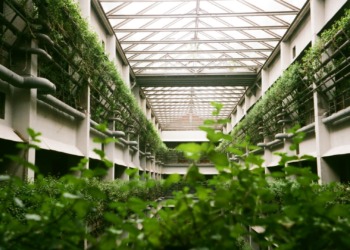This article on Travis County, Texas, is part of our Sustainable Cities series, done in collaboration with ICLEI — a global network of over 2,500 local and regional governments committed to sustainable urban development.
Travis County, Texas, has embraced a multifaceted approach to achieving Sustainable Development Goal 2 – Zero Hunger (SDG 2) while addressing various connected challenges, including reducing food waste and greenhouse gas (GHG) emissions. The County has integrated people-centered and equitable approaches into its initiatives.
Travis County’s sustainability journey took a significant step forward in 2018 when it adopted a resolution to develop a Climate Action Plan (CAP). The County’s first CAP was approved in June 2020, pinpointing buildings, employee commutes, and fleet vehicles as major emission sources.
Based on these findings, the County took proactive, high-impact actions to reduce emissions. The County’s adoption of an adaptive workplace policy has yielded promising results, eliminating 283 metric tons of carbon dioxide emissions and substantial savings in energy, water, and gas consumption, as detailed in a recent Telework Analysis 2024 Report.
Additionally, the County actively participates in Race to Zero and Race to Resilience initiatives, striving to achieve carbon neutrality by 2050 and enhance climate resilience for all residents within its jurisdiction.
Travis County hasn’t stopped at emissions reductions; instead, it has extended into social equity and community welfare. Amid the COVID-19 pandemic, Travis County witnessed exacerbated food insecurity, prompting intensified efforts to address the root causes.
“By addressing the interconnected challenges of poverty, food insecurity, and environmental stewardship, we pave the way for resilient communities where every individual thrives. Zero hunger is not just a goal; it reflects our commitment to fostering well-being and equity for all,” shared Travis County Commissioner Brigid Shea, who serves as the Board Chair of ICLEI – Local Governments for Sustainability USA.
Partnering With Community Organizations to Address Food Insecurity
In November 2022, Travis County awarded seven community organizations funding totaling $3,119,283 to increase access to food, prevent hunger, and promote wellness.
- Central Texas Food Bank: Offers a home delivery program to provide food to those experiencing food access and/or transportation barriers.
- El Buen Samaritano: Provides drive-thru food distribution events for families across Austin, including the Eastern Crescent.
- Farmshare Austin: Runs mobile markets in the County to improve access to healthy and fresh food.
- Foundation Communities: Serves residents with high-quality food through its food pantries.
- Sustainable Food Center: Offers mobile markets to reach more families in need, specifically those on the Supplemental Nutrition Assistance Program (SNAP) and women, infants, and children.
- Urban Roots: Operates two farms, offers education programs for teenagers and young adults, and shares food with other organizations focused on food distribution.
- Refugee Collective: Operates New Leaf Agriculture, a Certified USDA Organic farm where refugees from traditional farming cultures are trained, employed, and reconnected to farming in their new communities.
In addition to the 2022 funding, Travis County also purchased development rights on land in the form of a conservation easement where the Refugee Collective’s New Leaf Agriculture program not only utilizes the land for sustainable farming but also provides County residents with access to local organic produce and helps to offset GHG emissions through carbon soil sequestration.
In fiscal year 2023, Travis County’s funding through local partnerships supplied over 11.7 million meals; 38% total pounds provided was fresh produce and 80% of clients reported growing their own food.
Related Articles: Collective, Local Action for Global Impact: Del Carmen’s SDG Success Story | Fort Collins’ Sustainability Journey: A Testament to Holistic Nature Conservation | Colombia’s Capital Leads in Sustainable Transportation and Clean Mobility | Smart Cities: How to Meet the Challenge of a Growing Population | How Malmö is Using Innovative Procurement as a Tool for Circular Development | Becoming a Model Climate Action City: The Journey of Pasig, Philippines | The Line City of Saudi Arabia — a Greener Future? | Navigating the Climate Crisis: Insights From Beira, Mozambique
Travis County’s Supportive Programs for Residents

Travis County’s commitment to combating food insecurity extends beyond providing meals, recognizing it is woven into systemic issues such as inequitable access to food and affordable housing. The Austin/Travis County Food Plan aims to establish an equitable, sustainable, and resilient food system that ensures access to food for all community members, especially during emergencies and disasters.
With development and affordable childcare initiatives, the County aims to address these underlying issues and foster sustainable solutions for historically underserved communities.
Mapping Progress and Future Steps in Zero Hunger & Zero Waste
Impact measurement is integral to the County’s strategy, ensuring accountability and efficacy. While metrics primarily focus on poverty alleviation, Travis County strives to refine indicators specifically related to food insecurity.
Looking ahead, the County remains committed to building community resilience by promoting local food systems and reducing dependence on external supply chains. This includes continued efforts to promote residential sustainable gardening practices to support local food access and environmental stewardship. As part of the Cities Forward initiative, Travis County and the City of Austin collaborate with the City of Mérida, México, sharing expertise on topics such as food waste reduction and local agriculture to support Mérida’s project implementation.
By adopting a people-centered approach, Travis County is building thriving and resilient communities where zero hunger and zero waste are not just goals but a tangible reality.

Editor’s Note: The opinions expressed here by the authors are their own, not those of Impakter.com — In the Cover Photo: Lake Travis in Travis County. Cover Photo Credit: Dale Honeycutt.











